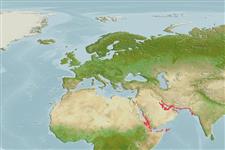>
Blenniiformes (Blennies) >
Blenniidae (Combtooth blennies) > Salariinae
Etymology: Atrosalarias: Latin, atro = black + Latin, salar, salaris = trout (Ref. 45335).
More on author: Rüppell.
Environment: milieu / climate zone / depth range / distribution range
Ekologi
laut berasosiasi dengan karang; kisaran kedalaman 2 - 12 m (Ref. 90102). Tropical; 30°N - 11°N, 28°E - 69°E
Indo-Pacific Ocean: including the Red Sea.
Size / Weight / umur
Maturity: Lm ? range ? - ? cm
Max length : 14.5 cm TL jantan/; (Ref. 90102)
Duri punggung (Keseluruhan (total)): 9 - 11; duri punggung lunak (Keseluruhan (total)): 18-20; Duri dubur 2; Sirip dubur lunak: 18 - 20; vertebrata, bertulang belakang: 33 - 35.
Adults inhabit sheltered, shallow reefs, hiding among live or dead coral branches (Ref. 1602). From estuaries to outer reef lagoons (Ref. 48636), 2-12 m deep. Solitary (Ref. 90102). Oviparous. Eggs are demersal and adhesive (Ref. 205), and are attached to the substrate via a filamentous, adhesive pad or pedestal (Ref. 94114). Larvae are planktonic, often found in shallow, coastal waters (Ref. 94114).
Oviparous, distinct pairing (Ref. 205).
Hastings, P.A. and V.G. Springer, 2009. Recognizing diversity in blennioid fish nomenclature (Teleostei: Blennioidei). Zootaxa 2120:3-14. (Ref. 82814)
Status IUCN Red List (Ref. 130435)
ancaman kepada manusia
Harmless
penggunaan manusia
informasi lanjut
AcuanBudidaya airprofil budidaya airStrainGenetikaElectrophoresesDiturunkanPenyakit-penyakitPengolahanNutrientsMass conversion
mitraGambarStamps, Coins Misc.Suara-suaraCiguateraKecepatanTipe renangArea insangOtolithsOtakPenglihatan / visi
Alat, peralatan
laporan khas
muat turun XML
Sumber internet
Estimates based on models
Preferred temperature (Ref.
123201): 24.9 - 29.3, mean 27.2 °C (based on 214 cells).
Phylogenetic diversity index (Ref.
82804): PD
50 = 0.6250 [Uniqueness, from 0.5 = low to 2.0 = high].
Bayesian length-weight: a=0.00871 (0.00463 - 0.01638), b=3.03 (2.86 - 3.20), in cm total length, based on LWR estimates for this species & (Sub)family-body (Ref.
93245).
Trophic level (Ref.
69278): 2.0 ±0.00 se; based on food items.
Daya lenting (Ref.
120179): Tinggi, Waktu penggandaan populasi minimum kurang dari 15 bulan (Preliminary K or Fecundity.).
Fishing Vulnerability (Ref.
59153): Low vulnerability (10 of 100).
